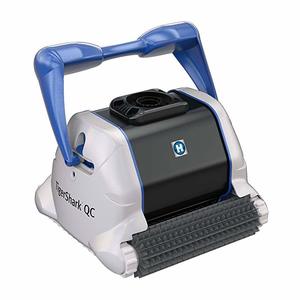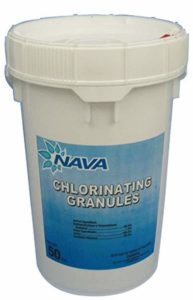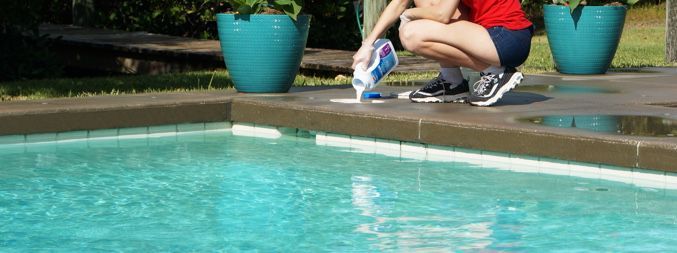How To Shock a Pool Guide For Beginners
If you have a swimming pool, then you know what it can look like if you do not take care of the water that is in it. Treating a pool with chemicals is pretty much the only way to keep bacteria and algae out of it. It requires a lot of diligence to keep it healthy and avoid that cloudy pool water. However, your job can be made much easier if you take the time to shock your pool.
Jump To: Top Pool Shock⇒

Best Pool Shock
Aqua Chem 5 Pack Xtra Blue
Check Price & AvailabilityIf you are looking for a good pool shock treatment, you may want to consider this type. Aqua Chem Xtra Blue is cost effective and kills all bacteria and algae to give you a crystal clear pool. It is usable in all types of swimming pools. It is guaranteed to reduce chlorine odors as well as eye irritation. It also will not increase your pool’s pH level. As an added bonus, you can swim within 15 minutes of putting it into the water as opposed to the normal 8 hours.
What is Pool Shock?
Every time you get into your swimming pool, you are adding contaminants to the water. There is no true, surefire way to prevent this from happening. Your skin is constantly shedding, your body is losing hair, you have soaps or lotions on your skin that rinse out into the water, and more. Mother Nature also adds stuff to your pool, even with the best swimming pool cover. There is always going to be dust and pollen in the air as well as leaves that may all get into your pool. All of these things may have a massive impact on how clear your water will be and unfortunately your Kreepy Krauly Pool Cleaner alone won’t be able to remove them. Therefore, most people put chlorine into their pool and you should continue to use chlorine even if you shock your pool because they do kill bacteria and break down all of the contaminates that get into the water.
Once the chlorine has attached to the unwanted things inside of your pool, it has done its job and it is no longer an active chlorine. This can make your pool water even cloudier unless you get rid of it. This is where shock treatments come in.
Shock oxidizes the dead chlorine, which turns it into a gas and that gas is then released into the air. You will know that it is doing its job because you will smell the chlorine as it is released into the air. By oxidizing it, your pool will be clearer and more enjoyable for everyone because no one wants to swim in a nasty looking pool.
When to Shock a Pool
Most pool shocking treatments should be done at night. The sun will make you lose the chlorine too quickly if you shock during the daytime when the sun is out because it dissolves before it is able to attach and oxidize. It is also good to do it at night because most shock treated pools cannot be swam in for 8 hours. You should also vacuum your pool prior and make sure any large debris has been removed (such as leaves, acorns, etc.) before your pool shock treatment is added. We recommend one of these robotic pool vacuums, such as the Hayward Tiger Shark Pool Cleaner, to reduce manual maintenance. Check Price & Availability
Check Price & Availability
How Often You Should Shock a Pool
You most likely test your pool at least weekly. If not, you should. Most of the time, the tests will tell you whether you have free or total chlorine content in the water. The more free chlorine you have, the more effectively your chlorine is killing bacteria. The total is how much of the chlorine in your water has already been used up. If the total is more than the free chlorine amounts, shocking will benefit your pool. Without a testing kit, if you smell really strong chlorine, you should also consider using shock because it is an indication that the organics and waste may have gotten out of hand and you are smelling the chloramine.
A shock treatment may also be a good idea if the pool usage has increased due to guests visiting, after heavy rains or wind, and of course, after you change the water in your swimming pool. The shock will bring all of your levels back into a healthy range
How to Use Pool Shock Treatment
In order to decide how you need to shock your pool, you must first figure out which type of shock treatment you need. There are four types available. Each one is useable for areas that may have specific issues.
Most Common Types Of Shock
Calcium Hypochlorite Shock
This shock treatment is best for all round shock. It contains 65% chlorine and it adds calcium to your pool water. You do need to dissolve it into a 5 gallon bucket of water before adding it to your pool if you want it to be more effective. It will also enable it to completely dissolve before going into your pool where it may sit undissolved and bleach your pool. You should do it at night because you cannot swim for 8 hours after putting it into the water. Check Price & Availability
Check Price & Availability
Lithium Hypochlorite Shock
If you have calcium in your water already, why add more? This is calcium free and you do not need to pre-dissolve it. You do still need to add it to your pool at night and avoid swimming for 8 hours after you put it in. However, this type of shock is rarely available due to an increase in demand in lithium.
DiChlor Shock
This type of shock is good if you live in hot areas. It adds cyanuric acid to your pool which is a chlorine stabilizer to prevent you losing chlorine as quickly via the sun. You do not have to pre-dissolve it, you should add it at night, and wait 8 hours to swim. Check Price & Availability
Check Price & Availability
Potassium Peroxymonosulfate or Non-Chlorine Shock
Some people use bromine in their pools rather than chlorine. If you are one of them, you need to use this type of shock treatment. It is chlorine free, does not need to be dissolved before adding it to the pool, can be added anytime, and within 15 minutes you can jump into the pool. If you do use chlorine, you can still safely add it to your pool.
Once you have the right shock treatment you will need to follow a few steps to ensure safety and proper shocking. These steps include wearing gloves and protective eye wear to prevent dust from getting on you, wearing old clothes to prevent bleaching good ones, use warm water to dissolve shock in a bucket and stir it with a wooden stick. The key is to add the shock to your pool slowly whether pre-dissolved or not.


